yeovil people
George Crocker
Ironmonger of the Borough
George Crocker was born in Babcary, Somerset, in 1813, one of the five children of George Crocker (1784-1819) and Joan née Morris (1777-1845). Nothing is known of his early life, but on 27 March 1834, at Sherborne, Dorset, he married by license Hannah Vincent (1812-1874), born in Bath, the daughter of John and Elizabeth Vincent of Wincanton. They were members of the Wincanton Wesleyan chapel. George and Hannah were to have ten children; James (b1835, Wincanton), George (b1836, Wincanton), Sarah (b1838, Wincanton), Mary (1839-1843), John (b1840), Tom (b1842, Yeovil), William (b1845, Yeovil), Elizabeth (b1848, Yeovil), Martha Cloake (b1849, Yeovil) and Edwin (b1851, Dorchester).
George Crocker was certainly an ironmonger of Wincanton as recorded by George Sweetman in his 1903 volume 'History of Wincanton, Somerset' which, in relation to the Wincanton Wesleyan Methodists, he records; "Mr George Crocker, an ironmonger here, and who died a few years since at Dorchester, was one of the main supporters... On Mr Crocker leaving for Yeovil, I believe the society languished and died out after a while." Sweetman continued "... After a while Mr George Crocker, who had an ironmongery business where Mr Shewen's shop is, changed shops with Mr Richards, each one's stock being removed. Later on, Mr Crocker left the town, when Mr Richards purchased Mr Crocker's stock of ironmongery, which hereafter was sold from one counter, and grocery from another... Mr George Crocker, who removed to Yeovil about 1840."
George was listed in the Somerset Gazette Directory of 1840 as an ironmonger of the Borough and the Churchwardens' Accounts recorded him several times throughout the 1840s.
In the 1841 census, George and Hannah, together with their first five children, were recorded living in High Street, in a property that had almost certainly been the earlier George Inn that was still trading in the 1770s. 25-year-old George gave his occupation as an ironmonger. In its edition of 12 June 1841, The Atlas listed George as the Yeovil agent of The London, Edinburgh and Dublin Guaranteed Mutual and Proprietary Life Assurance Company.
In 1846, the Special Commissioners took over the rights to the markets from the Phelips family, and they resolved to build a new Town Hall and markets that would also replace the old Tolle Hall or Court Chamber, Shambles, and Market House in the Borough. They bought several properties for the new site, including premises belonging to, or occupied by, Thomas Binford, Esq., Mr George Crocker, ironmonger, James Curtis, saddler and harness maker, a portion of the King's Head Inn (which already belonged to the Corporation), and a court called George Court. The Western Flying Post commented that “by destroying George Court, they will get rid of a great nuisance”. As it turned out, George Court was not demolished until the mid-1920's when King George Street was built.
George was to stay in Yeovil for some ten years, but by the time of the 1851 census he had moved his family to Dorchester, Dorset. He was living with his family in Pease Lane, Dorchester, but gave his occupation as an ironmonger's assistant - so perhaps the Yeovil venture had struggled financially. The 1861 census, at the same address, recorded George Crocker, age 48, ironmonger's assistant, with his children George 24, Sarah 23, Thomas 18, William 16, Elizabeth 12, Martha 11 and Edwin 9. The 1871 census recorded George, age 58, ironmonger's manager, with Hannah 59 and children Sarah 30, Elizabeth 23, and Martha Cloake 21, together with a visitor, a boarder and a servant.
In 1874, Hannah died in Dorchester, aged 62. The following year, at Alderbury, Wiltshire, 62-year-old George married Eliza Susannah Lambert (1830-1891).
The 1881 census recorded George and Eliza living at 38 South Street, Dorchester. He gave his occupation as an ironmonger. At 37 South Street were George's three daughters from his first marriage; Sarah, Elizabeth and Martha, together with three boarders and a domestic servant. All three daughters were unmarried and aged 44, 35 and 30 respectively. All three gave their occupations as teachers.
George Crocker died in Dorchester in 1890, aged 77.
map
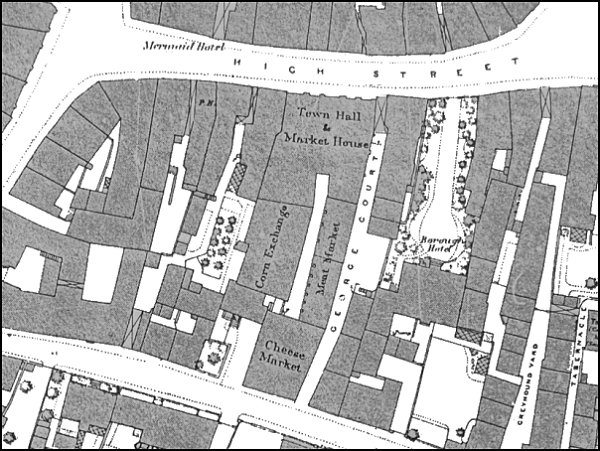
The 1886 Ordnance Survey showing the Town Hall & Market House, the Corn Exchange, Meat Market and the Cheese Market. George Court runs between High Street at the top of the map and South Street at the bottom and George Crocker's ironmongery was the building in High Street immediately right of George Court.
gallery
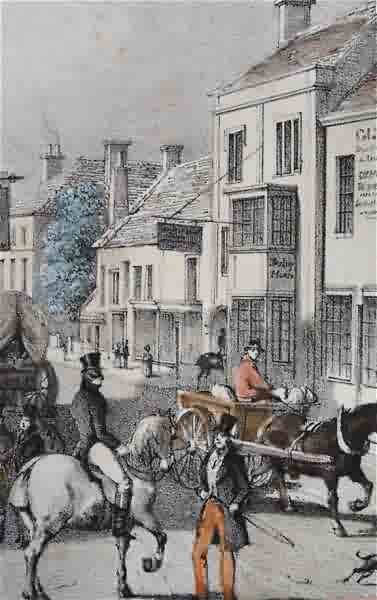
From my
collection. This
lithograph
features in my
book "Lost Yeovil"
It is probable that the building to the right of the tree was the former George Inn (or at least, the site of it). However the last record of the George Inn was in 1770 and certainly by 1820 the inn formerly known as the Three Cups in Middle Street was known as the George; therefore this may be the same building. The year after this 1839 image, the building became the ironmongery of George Crocker, until around 1850 when it became James Corfield's ironmongery.
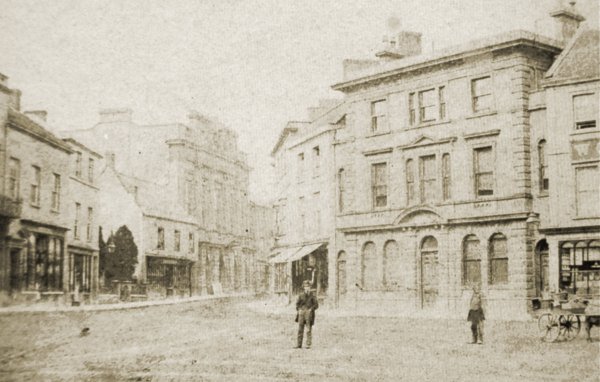
A very early photograph, dating to about 1860, shows High Street as seen from the Borough. Notice that at this stage the Town Hall lacks a clock tower which was not to be erected until 1864 but taken down in 1887 as unsafe. George Crocker's ironmongery business had occupied the two-storey building to the left of the Town Hall.
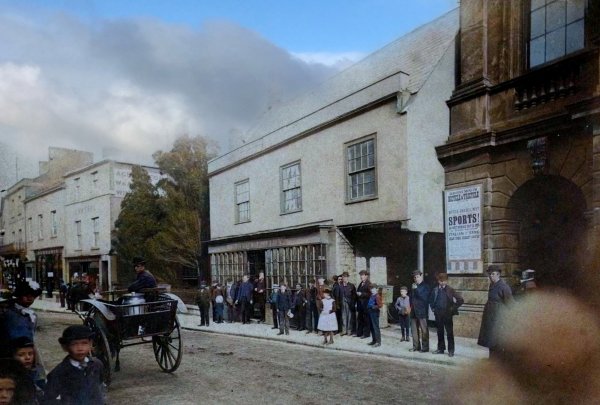
From the Stiby
Collection
(colourised),
Courtesy of South Somerset Heritage Collection
Denner & Stiby's shop photographed in 1883, probably by Henry Stiby who was a keen amateur photographer and left a good record of photographs of Yeovil. Note under the right of the three first floor windows is the entrance to the less-than-savoury George Court.
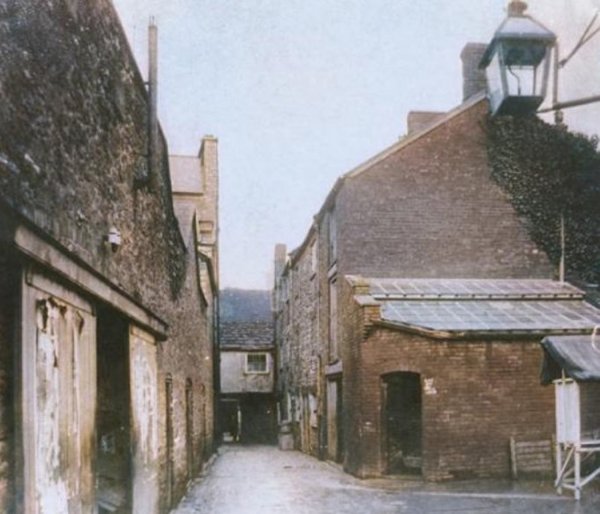
This
colourised photograph
features in my
book 'Secret Yeovil'.
This photograph dates to about 1915 and looks north along George Court towards High Street with the meat market at left and slum housing at right. At the end the 'flying freehold' is built over the tiny entrance to George Court - showing one of George Crocker's bedroom windows.
